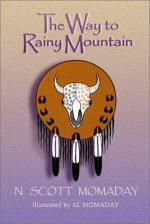|
This section contains 818 words (approx. 3 pages at 300 words per page) |

|
SOURCE: A review of The Way to Rainy Mountain, in Western Humanities Review, Vol. XXIV, No. 3, Summer, 1970, pp. 290-91.
In the review below, Dickey favorably assesses The Way to Rainy Mountain.
In a three-hundred-year migration, the Kiowa Indians emerged, as out of a hollow log, from the canyon confinement of the Montana Rockies, touched monolithic Devil's Tower which rose into the night sky to place seven of their kinsmen as the Big Dipper, and among the Comanches of the "intermountain plain" learned the Sun Dance and became horsemen—"a time of great adventure and nobility and fulfillment." "The Kiowas reckoned their stature by the distance they could see," and in the heart of the continent "acquired the sense of destiny, therefore courage and pride." Their golden age perished with the buffalo, "the animal representation of the sun," and these summerseeking people were at last quiescent near the Wichita...
|
This section contains 818 words (approx. 3 pages at 300 words per page) |

|


